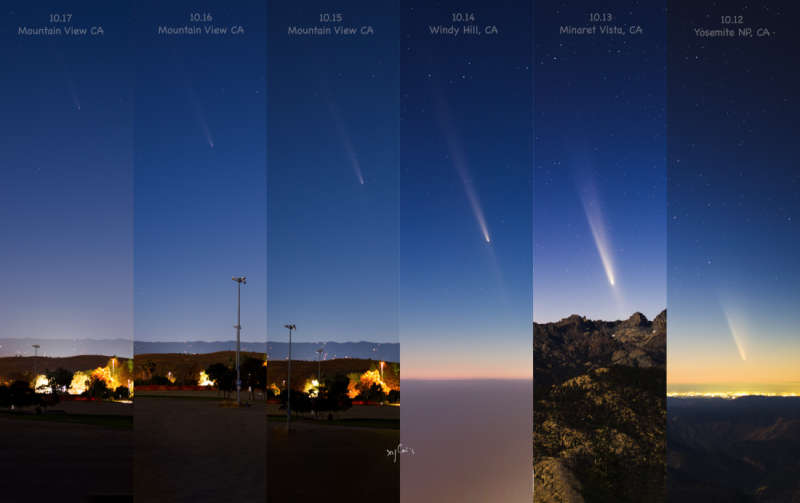Credit & Copyright: Xingyang Cai
Explanation:
These six panels follow daily apparitions of comet
C/2023 A3 Tsuchinshan-ATLAS
as it moved away from our
fair planet during the past week.
The images were taken with the same camera and lens at the
indicated dates and locations from California, planet Earth.
At far right on October 12
the
visitor
from the distant Oort cloud
was near its closest approach, some 70 million kilometers (about 4
light-minutes) away.
Its bright coma and long dust tail were
close on the sky to the setting Sun but still easy to spot against
a bright western horizon.
Over the following days, the outbound comet steadily climbs
above the ecliptic and north
into the darker western evening sky, but begins to fade from view.
Crossing the Earth's orbital plane around October 14,
Tsuchinshan-ATLAS exhibits a noticeable
antitail extended toward the western horizon.
Higher in the evening sky at sunset by October 17 (far left)
the comet has faded and reached a distance of around 77 million
kilometers from planet Earth.
Hopefully
you enjoyed
some of Tsuchinshan-ATLAS's bid to become
the best comet of 2024.
This
comet's
initial orbital period estimates were a mere 80,000 years, but
in
fact
it may never return to the inner Solar System.
Growing Gallery:
Comet
Tsuchinshan-ATLAS in 2024
1999 2000 2001 2002 2003 2004 2005 2006 2007 2008 2009 2010 2011 2012 2013 2014 2015 2016 2017 2018 2019 2020 2021 2022 2023 2024 2025 |
Yanvar' Fevral' Mart Aprel' Mai Iyun' Iyul' Avgust Sentyabr' Oktyabr' Noyabr' Dekabr' |
NASA Web Site Statements, Warnings, and Disclaimers
NASA Official: Jay Norris. Specific rights apply.
A service of: LHEA at NASA / GSFC
& Michigan Tech. U.
|
Publikacii s klyuchevymi slovami:
comet - komety
Publikacii so slovami: comet - komety | |
Sm. takzhe:
Vse publikacii na tu zhe temu >> | |
